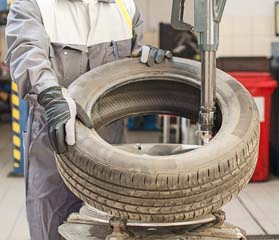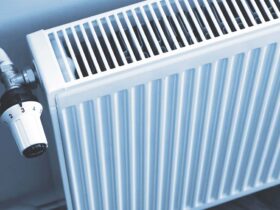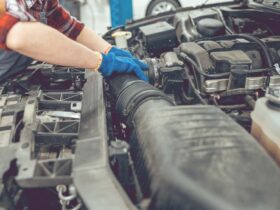Bead balancing is a process used to balance tires by adding small beads inside. This technique helps to reduce vibrations and improve overall tire performance.
Bead balancing is a popular method used to balance tires effectively. By placing small beads inside the tire, vibrations can be minimized, resulting in a smoother and more stable ride. This technique works by evenly distributing the weight around the tire, eliminating the need for traditional balancing methods such as weights.
Bead balancing is not only useful for regular vehicles but also for off-road vehicles and heavy machinery. It is an efficient way to enhance tire performance and ensure optimal driving experience. So, if you’re looking for a reliable and efficient way to balance your tires, bead balancing is worth considering.
Understanding Bead Balancing For Tires
When it comes to maintaining the performance and longevity of your vehicle, proper tire balancing is crucial. One effective method of tire balancing is bead balancing, which involves the use of small beads strategically placed inside the tire to balance the wheel assembly. In this blog post, we will dive into the importance of tire balancing and the effects of imbalanced tires.
Importance Of Tire Balancing
Tire balancing is a vital aspect of vehicle maintenance that often gets overlooked. Properly balanced tires offer several advantages, including:
- Improved tire life: Tire balancing helps distribute the weight evenly across the tire, reducing unnecessary wear and tear. This leads to longer tire life and ultimately saves you money.
- Enhanced safety: Imbalanced tires can lead to vibrations, which can make your vehicle more difficult to handle, especially at higher speeds. By balancing your tires, you can ensure a smoother, safer driving experience.
- Increased fuel efficiency: Imbalanced tires can cause your vehicle to work harder, resulting in decreased fuel efficiency. Balancing your tires helps optimize the performance of your vehicle and can contribute to better gas mileage.

Effects Of Imbalanced Tires
Ignoring tire balancing can have several negative consequences for your vehicle. Here are some effects of imbalanced tires:
- Uneven tire wear: When your tires are imbalanced, certain areas of the tire will experience more pressure and wear, while other areas may remain relatively unaffected. This can result in uneven tread wear, reducing the lifespan of your tires.
- Vibration: Imbalanced tires often cause vibrations, which can be felt through the steering wheel or the vehicle itself. These vibrations not only diminish driving comfort but can also lead to long-term damage to the suspension system.
- Poor handling: Unbalanced tires can negatively impact your vehicle’s handling, making it more challenging to control and maneuver. This can be particularly hazardous in emergency situations or during inclement weather.
As you can see, understanding bead balancing for tires and the importance of tire balancing is crucial for maintaining the performance, safety, and efficiency of your vehicle. By ensuring your tires are properly balanced, you can enjoy a smoother and more enjoyable driving experience while protecting your investment.
Traditional Tire Balancing Methods
In the world of tire balancing, there are two traditional methods that stand out: Static Balancing and Dynamic Balancing. These methods have been used for decades to ensure optimal tire performance and safety. Let’s take a closer look at each one.
Static Balancing
Static balancing is a simple and straightforward method used to balance tires. It involves placing the tire on a static balancing machine, which consists of a stationary axle with two spindle plates. The spindle plates support the tire while allowing it to rotate freely.
During the static balancing process, the machine analyzes the distribution of weight in the tire and identifies any areas of imbalance. These imbalances are typically caused by variations in tire construction, tread wear, or tire damage.
Once the imbalances are identified, small weights are strategically attached to the rim of the tire to counteract them. These weights are carefully positioned in specific locations to ensure the tire is balanced around the axle. Static balancing is often sufficient for most passenger cars and standard vehicles.
Dynamic Balancing
Dynamic balancing takes the tire balancing process a step further by addressing dynamic forces that occur while driving. This method is particularly important for high-speed applications, heavy-duty vehicles, and vehicles with performance tires.
Dynamic balancing involves mounting the tire on a dynamic balancing machine, similar to a static balancing machine, but with an additional component – a road wheel simulator. This simulator replicates the forces exerted on the tire while driving, including acceleration, braking, and cornering.
As the tire rotates on the machine, sensors measure and analyze the forces acting upon it. This allows for a more accurate detection of any imbalance issues. The machine then suggests the placement of counterbalance weights on the rim of the tire to eliminate the imbalances, ensuring smooth and vibration-free driving.

The Benefits Of Traditional Tire Balancing Methods
Using traditional tire balancing methods like static and dynamic balancing helps achieve several key benefits:
- Improved Tire Performance: Balancing tires ensures even weight distribution, reducing vibration and extending tire life.
- Enhanced Vehicle Safety: Balanced tires provide better traction, handling, and braking, resulting in increased safety on the road.
- Reduced Wear and Tear: Balanced tires experience less stress and wear on suspension components, leading to potential cost savings over time.
Whether you opt for static balancing or dynamic balancing, these traditional methods play a crucial role in maintaining optimal tire performance and safety. They ensure a smooth and comfortable ride while extending the life of your tires and protecting your vehicle.
The Innovation Of Bead Balancing
When it comes to tire balancing, the innovation of bead balancing has revolutionized the way we address tire vibration and imbalance issues. Unlike traditional methods, bead balancing offers a more efficient and effective solution, ensuring tires run smoothly and maintain optimal performance.
How Bead Balancing Works
Bead balancing utilizes small beads, typically made of glass or ceramic, that are placed inside the tire. These beads automatically adjust to the imbalance of the tire as it rotates, redistributing weight to counteract any discrepancies and ensure uniform balance throughout the entire circumference of the tire. This dynamic self-adjusting process effectively eliminates the need for traditional wheel weights, providing a more precise and consistent balance.
Advantages Over Traditional Methods
- Bead balancing offers continuous and automatic adjustments, maintaining balance as tire wear occurs
- It ensures a smoother ride and reduces the risk of uneven tire wear, ultimately extending the lifespan of the tires
- This innovative method is environmentally friendly, as it eliminates the need for lead wheel weights
Choosing The Right Bead Balancing Products
When it comes to tire maintenance, ensuring proper balance is crucial for a smooth and safe ride. Bead balancing has gained popularity as an effective method to achieve optimal tire balance and performance. By adding the right type of beads to your tires, you can eliminate vibrations, increase tire life, and improve fuel efficiency. To make the most out of bead balancing, it’s essential to choose the right products that suit your specific requirements. In this article, we will explore the types of beads available in the market and discuss compatibility and installation considerations.

Types Of Beads Available
When it comes to bead balancing, there are various types of beads available in the market. These beads are often made from materials like ceramic, glass, or steel, and they come in different sizes and shapes. Some of the common types of beads used for tire balancing include:
- Ceramic Beads: Ceramic beads are small, round beads made from hardened ceramic. They are lightweight, durable, and provide excellent balance. Due to their non-corrosive nature, ceramic beads are suitable for all types of tires.
- Glass Beads: Glass beads are tiny, spherical beads that are lightweight and environmentally friendly. They are commonly used in passenger car tires and can provide significant improvements in tire balance.
- Steel Beads: Steel beads are heavier and larger compared to ceramic and glass beads. They are commonly used in heavy-duty or off-road tires that require additional stability and strength. Steel beads are known for their reliability and durability.
Compatibility And Installation
Before choosing a bead balancing product, it’s important to consider the compatibility with your tires. Different types of tires require specific bead sizes and weights. It is recommended to refer to the manufacturer’s guidelines or consult a professional to ensure compatibility.
When it comes to installation, bead balancing products can be easily added to your tires through the valve stem or by breaking the tire’s bead and rotating it to distribute the beads evenly. It is crucial to follow the manufacturer’s instructions for the correct installation procedure.
Moreover, it’s essential to note that bead balancing products can be used for both new and existing tires. If you’re installing the beads in an existing tire, it’s recommended to clean the tire and remove any excess debris or water before installation. This ensures optimum performance and longevity of the bead balancing solution.
Benefits Of Bead Balancing For Tires
When it comes to maintaining your vehicle’s performance and safety, one essential aspect to consider is tire balance. Unbalanced tires can lead to uncomfortable rides, increased tire wear, and even reduced fuel efficiency. That’s where bead balancing for tires comes into the picture. By utilizing tiny beads that are strategically placed inside the tires, this balancing method offers a range of benefits that can significantly improve your driving experience and extend the lifespan of your tires.
Improved Ride Comfort
One of the most noticeable benefits of bead balancing for tires is the improvement it brings to your ride comfort. With the beads evenly distributed inside the tire, any imbalances caused by weight discrepancies are effectively minimized. This results in a smoother and more stable ride, reducing vibrations and eliminating the annoying steering wheel wobbles that can make your journey less enjoyable. Say goodbye to uncomfortable rides and hello to a more pleasurable driving experience.

Extended Tire Life
Another key advantage of bead balancing for tires is the extended lifespan it offers. Unbalanced tires can cause uneven wear patterns, leading to premature tire deterioration and the need for frequent replacements. By implementing bead balancing, the tire wear is distributed evenly, ensuring each area of the tire bears the same load. This effectively prevents excessive wearing in certain spots, allowing your tires to last longer and saving you money in the long run. With bead balancing, you can maximize the lifespan of your tires and keep them in optimal condition for longer.
Step-by-step Bead Balancing Process
When it comes to tire maintenance, bead balancing is a crucial process that ensures a smooth and safe ride. This step-by-step guide will walk you through the preparation, application, and testing of bead balancing for tires, helping you achieve optimal performance and even wear.
Preparation Steps
Proper preparation is essential for effective bead balancing. Here’s what you need to do before starting the process:
- Ensure the tire is clean and free from any debris or moisture.
- Inspect the wheel and valve stem for any damage or signs of wear.
- Check the tire pressure and adjust as needed to the manufacturer’s specifications.
- Gather the necessary tools and materials, including balancing beads and a suitable applicator.
Application And Testing
Once you have completed the preparation steps, it’s time to apply and test the bead balancing process:
- Insert the appropriate amount of balancing beads into the tire, following the manufacturer’s guidelines.
- Securely reinstall the valve core and inflate the tire to the recommended pressure.
- Drive the vehicle to allow the beads to distribute evenly within the tire, ensuring a balanced rotation.
- Perform a road test to evaluate the smoothness and stability of the tire’s performance.

Real-world Performance And Testimonials
When it comes to ensuring the optimal performance of your vehicles, tire balancing is an essential aspect that should not be overlooked. One effective method of tire balancing is bead balancing, which offers numerous benefits and has gained popularity among vehicle owners. But what exactly is bead balancing, and how does it perform in the real world? Let’s take a closer look at user experiences and professional feedback to understand its effectiveness.
User Experiences
Countless vehicle owners have witnessed the impressive performance of bead balancing for their tires. It not only enhances the overall driving experience but also ensures a smoother ride, improved fuel efficiency, and extended tire life. Users have reported experiencing reduced vibrations, increased stability, and enhanced traction on various road surfaces.
One satisfied user, John, shared his experience with bead balancing: “I was skeptical at first, but after trying bead balancing, I can’t imagine going back to traditional tire balancing methods. The difference in ride quality is noticeable, and the improved fuel efficiency is a fantastic bonus!”
Another user, Sarah, expressed her satisfaction with bead balancing, stating, “I used to struggle with uneven tire wear and constant vibrations. After getting bead balancing, those problems are a thing of the past. My tires last longer, and my driving experience has vastly improved.”
Professional Feedback
Automotive professionals and tire experts have also recognized the benefits of bead balancing. According to many professionals in the industry, bead balancing provides a reliable and cost-effective solution for tire balancing. It not only eliminates the need for traditional wheel weights but also ensures a more precise and consistent balancing result.
Bob Johnson, a certified automotive technician, shares his professional opinion: “Having worked with various tire balancing techniques, I find bead balancing to be highly effective. It offers improved precision, reduces the chances of imbalanced tires, and provides a smoother ride for customers. I highly recommend it.”
Furthermore, tire manufacturers have conducted extensive tests on bead balancing and its impact on tire performance. The results have consistently shown improved stability, better traction, and minimized tire wear. Many leading tire brands now recommend and endorse bead balancing for optimal tire performance.
In conclusion, the real-world performance of bead balancing is unquestionable, backed by positive user experiences and professional feedback. Whether you’re a vehicle owner looking to enhance your driving experience or a tire professional seeking an efficient balancing method, bead balancing proves to be a reliable and effective solution.
Conclusion: Maximizing Tire Performance With Bead Balancing
Maximize tire performance with bead balancing, ensuring smooth and vibration-free driving. This method distributes weight evenly, reducing tire wear and improving overall vehicle handling. Bead balancing is a cost-effective solution for maintaining optimal tire performance and extending tire life.
Final Recommendations
After considering the benefits and advantages of bead balancing for tires, it is evident that this technique plays a crucial role in maximizing tire performance. To ensure optimal tire balance, the following recommendations can be followed:
- Regular Maintenance: It is essential to conduct regular tire maintenance to prevent any imbalances or issues. This includes checking the tire pressure, tread wear, and overall condition of the tires.
- Use Professional Services: Instead of attempting to balance the tires yourself, it is recommended to seek professional services. They have the expertise and equipment necessary to perform bead balancing effectively.
- Choose Quality Beads: When opting for bead balancing, selecting high-quality beads is paramount. Inferior quality beads may lead to inconsistent balance and reduced tire performance.
- Frequently Monitor Balancing: Tires can experience changes in their balance over time. Therefore, it is important to monitor their balance regularly, especially after suspension modifications or prolonged use.
- Maintain Proper Inflation: Proper tire inflation is essential, as underinflated or overinflated tires can affect balance and overall performance. Check the manufacturer’s recommendations for the correct tire pressure.
- Consider Wheel Alignment: In addition to bead balancing, it is recommended to have regular wheel alignments. This ensures the tires are properly aligned with the vehicle’s suspension, improving overall tire performance.
Future Trends
The world of tire balancing continues to evolve and adapt to new technologies. As the automotive industry progresses, we can expect the following future trends:
- Smart Tire Balancing: With advancements in technology, we may witness the emergence of smart tire balancing systems. These systems will utilize sensors and artificial intelligence to continuously monitor and adjust tire balance automatically.
- Innovative Balancing Materials: Research and development efforts are focused on discovering new materials that offer enhanced tire balancing capabilities. These innovative materials can further improve tire performance and longevity.
- Integration with Vehicle Systems: Future trends may introduce tire balancing systems that are integrated with the vehicle’s internal systems. This integration will allow for real-time monitoring and adjustments based on various factors like road conditions and driving behavior.
- Efficiency and Sustainability: As the automotive industry increasingly emphasizes sustainability, tire balancing techniques will likely become more eco-friendly and energy-efficient. This includes the development of more sustainable balancing materials and processes.
By staying informed about these future trends and advancements, we can further optimize tire performance and ensure a smoother and safer driving experience.
Frequently Asked Questions Of Bead Balancing For Tires
Do Beads Work To Balance Tires?
Yes, beads can help balance tires. They are placed inside the tire and distribute weight evenly, reducing vibration and improving performance.
How Long Do Balancing Beads Last?
Balancing beads typically last for the entire life of a tire. They provide long-lasting balance and stability without needing to be replaced.
Are Balancing Beads Better Than Wheel Weights?
Yes, balancing beads are better than wheel weights as they provide continuous balance, reduce vibrations, and extend tire life.
Conclusion
Bead balancing is a simple yet effective way to ensure smooth and efficient tire performance. By redistributing weight evenly, it enhances vehicle safety and reduces vibration. With its cost-effectiveness and eco-friendliness, bead balancing offers a practical solution for tire maintenance.
Explore this method to enhance your driving experience.





